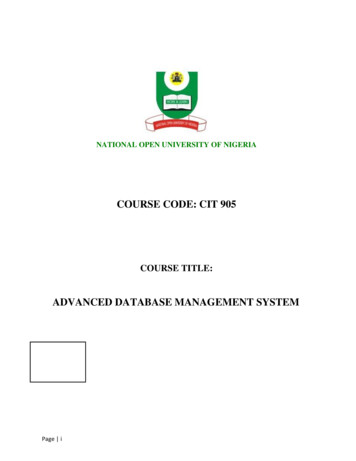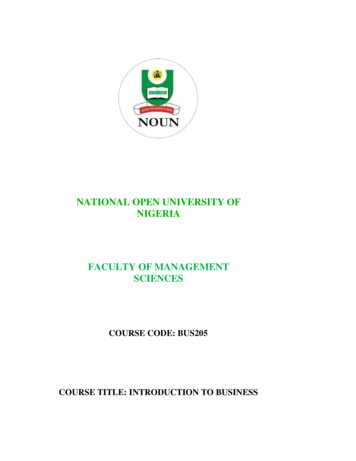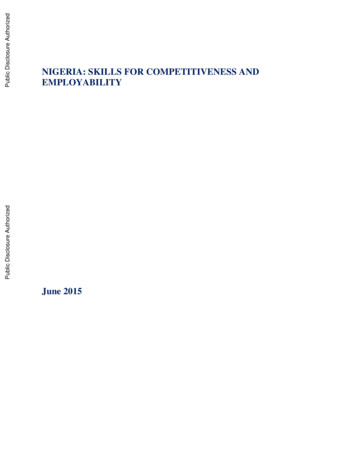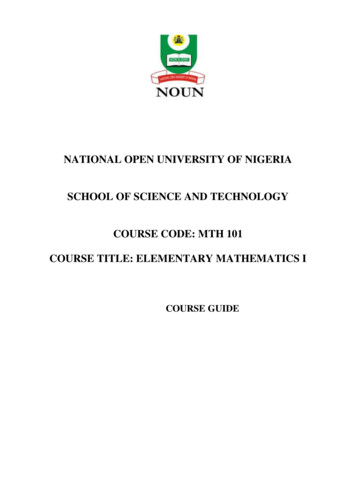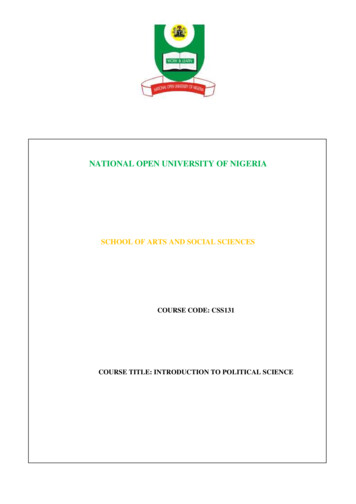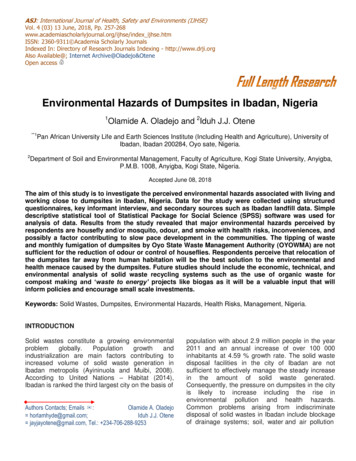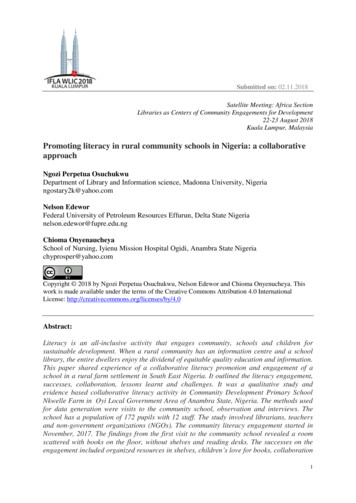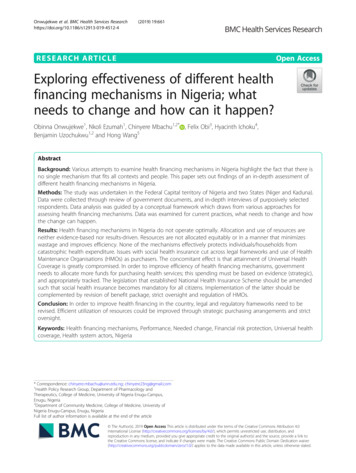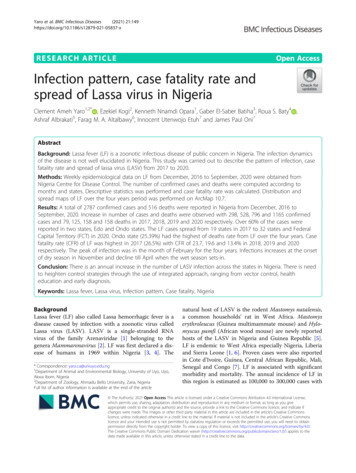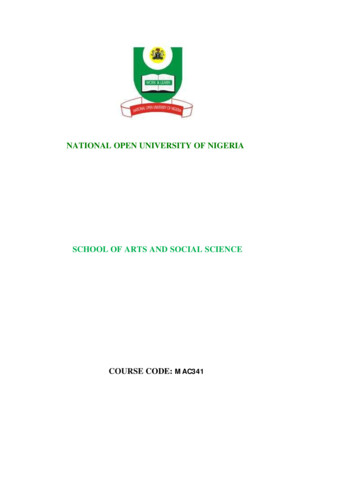
Transcription
NATIONAL OPEN UNIVERSITY OF NIGERIASCHOOL OF ARTS AND SOCIAL SCIENCECOURSE CODE: MAC341
MAC341COURSE GUIDECOURSE TITLE:DEVELOPMENT COMMUNICATION ANDBROADCASTINGii
MAC341COURSE GUIDECOURSEGUIDEMAC341DEVELOPMENT COMMUNICATION ANDBROADCASTINGCourse TeamDr. Olusola Oyero (Developer/Writer) - CovenantDr. Josef Bel-Molokwu (Editor)Chidinma H.Onwubere, Ph.D (Coordinator) - NOUNChristine I. Ofulue, Ph.D (Programme Leader) -NOUNiii
MAC341NATIONAL OPEN UNIVERSITY OF NIGERIAivCOURSE GUIDE
MAC341COURSE GUIDENational Open University of NigeriaHeadquarters14/16 Ahmadu Bello WayVictoria IslandLagosAbuja OfficeNo. 5 Dar es Salaam StreetOff Aminu Kano CrescentWuse II, AbujaNigeriae-mail: centralinfo@nou.edu.ngURL: www.nou.edu.ngPublished By:National Open University of NigeriaFirst Printed 2012v
MAC341COURSE GUIDEISBN: 978-058-251-7All Rights ReservedCONTENTSPAGEIntroduction .1Course Aims .1Course Objectives . 1Working through This Course . . .2Understanding the Course 2Course Materials . 2Study Units .2Textbooks and References 3How to Get the Best from This Course 4Summary .vi5
MAC341COURSE GUIDEvii
IntroductionYou are welcome to the course material designed for MAC314(Development Communication). This course deals with the role ofcommunication in the development process. Attention will be given tothe role of mass media and other communication networks, as well asother multimedia and indigenous approaches to communication in thedevelopment process. The course will also focus on development issuessuch as environment, HIV/AIDS, agriculture, census population,education, child rights, politics, e.t.c; and communication types andmodels appropriate for the development of these various sectors willbe identified and evaluated. Do make the best out of this course byreading through all its contents, paying attention to the objectives ofeach unit and attempting all the self-assessment tests, as well as thetutor-marked assignments.Course AimsThe aims of this course are to:1.2.3.Introduce students to the basic elements of developmentcommunication,Explain the role of the media in development communicationandEquip students with foundational knowledge and skills involvedin development communication task.Course ObjectivesThere are objectives to achieve in units of the course. You should readthem before studying each unit. It is expected that by the time youhave finished studying this course, you should be able to:
MAC341 DEVELOPMENT COMMUNICATION AND BROADCASTINGDefine development, communication and national development.Discuss the evolution and concepts of developmentcommunication.List the functions of development communicationExplain the basic theories, models and paradigms ofdevelopment communication and development issues.Identify the problems and prospects of developmentcommunication in the development processes/ nprogrammes.Working through This CourseTo fully benefit from this course, you are expected to read the studyunits and other materials provided by NOUN. Each unit containsassignments; you are required to carry out the assignments, which willbe marked by assessors appointed by the NOUN. Remember, allcomponents of this course contribute to your total success. So, takeyour time to read, and study them effectively in order to successfullyderive the best from the course.Understanding the CourseThis course can easily be understood if you as the student caneffectively go through all the study units as well as make an attempt toanswer the self assessment exercises and tutor marked assignmentsprovided at the end of each unit. Extra efforts should also be made toii
MAC341DEVELOPMENT COMMUNICATION AND BROADCASTINGsource for the recommended texts for better understanding of thevarious topics discussed.Course MaterialsThe basic materials you will need for this course include:1.2.3.4.Course GuideStudy UnitsAssignment FileRelevant Textbooks including the ones provided at the end ofeach unitStudy UnitsThis course comprises four major modules under which are 22 relevantstudy units. They are as follows:Module 1Development Communication-Meaning and ParadigmsUnit 1The Concepts of Communication, Development andDevelopment CommunicationUnit 2Paradigms of Development CommunicationUnit 3Development JournalismUnit 4Participatory Development CommunicationUnit 5Community Developmentiii
MAC341DEVELOPMENT COMMUNICATION AND BROADCASTINGModule 2Issues and Roles of Development CommunicationUnit 1Issues in DevelopmentDevelopmentUnit 2Roles of Communication in DevelopmentUnit 3Key Facts andCommunicationUnit 4Understanding the Scope and Uses of DevelopmentCommunicationUnit 5Advocacy JournalismModule 3Media for Development CommunicationUnit 1The Use of Interpersonal Channels for DevelopmentCommunicationUnit 2The Use of Print Media for Development CommunicationUnit 3The Use of Radio for Development CommunicationUnit 4The Use of Television and Video for DevelopmentCommunicationUnit 5The use of Folk-MediaCommunicationUnit 6The Use of New Media Technologies for DevelopmentCommunicationUnit 7Community Media in Development forforDevelopmentDevelopment
MAC341DEVELOPMENT COMMUNICATION AND BROADCASTINGModule 4Theories and Models of Development CommunicationUnit 1Development Communication Related TheoriesUnit 2Diffusion of Innovation TheoryUnit 3ACADA Model of Development CommunicationUnit 4P-Process ModelUnit 5Research, Monitoring and Evaluation in DevelopmentCommunicationTextbooks and ReferencesEach unit has a set of recommended textbooks for references of study.Today, knowledge is in public space; so you are also encouraged toread books that are relevant to the themes of the course, even whennot recommended. In addition, you can visit the Internet to enhanceyour chances of achieving your learning task.How to Get the Most from This CourseIn distance learning, the study units replace the university lecture. Thisis one of the great advantages of distance learning; you can read andwork through specially designed study materials at your own pace, andat a time and place that suits you best. Think of it as reading the lecturev
MAC341DEVELOPMENT COMMUNICATION AND BROADCASTINGinstead of listening to the lecturer. In the same way a lecturer mightgive you some reading to do, the study units tell you where to read,and which are your text materials or set books. You are provided withexercises to do at appropriate points, just as a lecturer might give youan in-class exercise. Each of the study units follows a common format.The first item is an introduction to the subject matter of the unit, andhow a particular unit is integrated with the other units and the courseas a whole. Next to this is a set of learning objectives. These objectiveslet you know what you should be able to do by the time you havecompleted the unit. These learning objectives are meant to guide yourstudy. The moment a unit is finished, you must go back and checkwhether you have achieved the objectives. If this is made a habit, thenyou will significantly improve your chances of passing the course. Themain body of the unit guides you through the required reading fromother sources. This will usually be either from your set books or from aReading section. The following is a practical strategy for workingthrough the course. If you run into any trouble, telephone your tutor.Remember that your tutor’s job is to help you. When you needassistance, do not hesitate to call and ask your tutor to provide it.1.2.3.4.5.viRead this Course Guide thoroughly, it is your first assignment.Organize a Study Schedule. Design a ‘Course Overview’ to guideyou through the Course. Note the time you are expected tospend on each unit and how the Assignments relate to the units.Whatever method you choose to use, you should decide on andwrite in your own dates and schedule of work for each unit.Once you have created your own study schedule, do everythingto stay faithful to it. The major reason students fail is that theyget behind with their course work. If you get into difficulties withyour schedule, please, let your tutor know before it is too late tohelp.Turn to Unit I, and read the introduction and the objectives forthe unit.Assemble the study materials. You will need your set books inthe unit you are studying at any point in time. As you workthrough the unit, you will know what sources to consult forfurther information.
MAC3416.7.8.9.10.11.DEVELOPMENT COMMUNICATION AND BROADCASTINGKeep in touch with your study centre. Up-to-date courseinformation will be continuously available there.Keep in mind that you will learn a lot by doing the assignmentcarefully and well before the relevant due dates. Theassignments have been designed to help you meet theobjectives of the course and, therefore, will help you pass theexamination. Submit all assignments not later than the due date.Review the objectives for each study unit to confirm that youhave achieved them. If you feel unsure about any of theobjectives, review the study materials or consult your tutor.When you are confident that you have achieved a unit’sobjectives, you can start on the next unit. Proceed unit by unitthrough the course and try to pace your study so that you keepyourself on schedule.When you have submitted an assignment to your tutor formarking, do not wait for its return before starting on the nextunit. Keep to your schedule. When the assignment is returned,pay particular attention to your tutor’s comments, both on thetutor-marked assignment form and also the written commentson the ordinary assignments.After completing the last unit, review the course and prepareyourself for the final examination. Check that you have achievedthe unit objectives (listed at the beginning of each unit) and thecourse objectives (listed in the Course Guide).SummaryThis course guide has provided an overview of what to expect in thecourse of this study. It is hoped that you will find it very useful. Wishingyou the very best in the course.vii
MAC341DEVELOPMENT COMMUNICATION AND BROADCASTINGCourse CodeCourse TitleMAC341Development Communication and BroadcastingCourse TeamDr. Olusola Oyero (Developer/Writer) - CovenantDr. Josef Bel-Molokwu (Editor)Chidinma H.Onwubere, Ph.D (Coordinator) - NOUNChristine I. Ofulue, Ph.D (Programme Leader) -NOUNviii
MAC341DEVELOPMENT COMMUNICATION AND BROADCASTINGNATIONAL OPEN UNIVERSITY OF NIGERIAix
MAC341DEVELOPMENT COMMUNICATION AND BROADCASTINGNational Open University of NigeriaHeadquarters14/16 Ahmadu Bello WayVictoria IslandLagosAbuja OfficeNo. 5 Dar es Salaam StreetOff Aminu Kano CrescentWuse II, AbujaNigeriae-mail: centralinfo@nou.edu.ngURL: www.nou.edu.ngPublished By:National Open University of NigeriaFirst Printed 2012ISBN: 978-058-251-7All Rights Reservedx
MAC341DEVELOPMENT COMMUNICATION AND BROADCASTINGCONTENTSModule 1PAGEDevelopment Communication-Meaning andParadigms . . 1Unit 2Unit 3Unit 4Unit 5The Concepts of Communication, Development andDevelopment Communication . Paradigms of Development Communication .Development Journalism . .Participatory Development Communication Community Development . .112213446Module 2Issues and Roles of Development Communication. 61Unit 1Unit 5Issues in Development and Communication forDevelopment . 61Roles of Communication in Development . 69Key Facts and Appellations of DevelopmentCommunication . 80Understanding the Scope and Uses of DevelopmentCommunication . 89Advocacy Journalism 100Module 3Media for Development Communication . 108Unit 1The Use of Interpersonal Channels for DevelopmentCommunication .108The Use of Print Media for DevelopmentCommunication .118The use of Radio for Development Communication 133The use of Television and Video for DevelopmentCommunication . 144The use of Folk-Media Media for DevelopmentCommunication .154The Use of New Media Technologies for DevelopmentCommunication 164Community Media in Development Communication 171Unit 1Unit 2Unit 3Unit 4Unit 2Unit 3Unit 4Unit 5Unit 6Unit 7Module 4Theories and Models of DevelopmentCommunication . 180Unit 1Unit 2Unit 3Unit 4Unit 5Development Communication Related Theories. Diffusion of Innovation Theory .ACADA Model of Development Communication P-Process Model .Research, Monitoring and Evaluation in DevelopmentCommunication .180190200214223xi
MAC341DEVELOPMENT COMMUNICATION AND BROADCASTINGMODULE 1Unit 1DEVELOPMENT COMMUNICATIONMEANING AND PARADIGMSThe concepts of Communication, Development andDevelopment CommunicationParadigms of Development CommunicationDevelopment JournalismParticipatory Development CommunicationCommunity DevelopmentUnit 2Unit 3Unit 4Unit 5UNIT 1THE CONCEPTS OF vesMain Content3.1The nt CommunicationConclusionSummaryTutor-Marked AssignmentReferences/Further Reading1.0INTRODUCTIONThe relevance of communication to development is an establishedparadigm in development studies. It is borne out of the realisation thatdevelopment is human-centred and thus requires communication for itsfull realisation. FAO (1994:5) points out that “communication is the keyto human development and the thread that binds people together”. Thiscorroborates Moemeka’s (1991) view that development efforts cannotbe successful without planned communication because its flowdetermines the direction and pace of dynamic social development. It isthe agglutination of communication and development that birthed theword development communication. It is to emphasize the kind ofcommunication that is done for development purposes. It is also knownas communication for development. Some scholars call itcommunication in development, while others refer to it as "developmentsupport communication", that is, communication in support1
MAC341DEVELOPMENT COMMUNICATION AND BROADCASTINGcommunication of development. These nomenclatures establish thatthere is a close relationship between communication and development.2.0OBJECTIVESAt the end of this unit, you should be able to: define communicationexplain the process of communicationdefine developmentexplain different dimensions of developmenthighlight the objectives of developmentdefine development communicationestablish a relationship between communication anddevelopment.3.0MAIN CONTENT3.1CommunicationThere exist various kinds of definition for communication, as there aredifferent disciplines. While some definitions are human centred, othersare not.For example, communication system may incorporateprocessing like computers, as well as less sophisticated reproducingdevices such as photocopiers. A photocopier may see communication asmeaning different thing from the way a marketer perceives it. Similarly,a gospel preacher may think communication is something, which is ofcourse different from what a journalist thought it is.There is no single definition of communication agreed upon by scholars.Psychologists, sociologists, medical practitioners, philosophers andcommunication specialists, all define communication based on theirorientations and perspectives. Psychologists define communication as"the process by which an individual (the communicator) transmitsstimuli (usually verbal symbols) to modify the behaviour of the otherindividuals (communicates)." This definition describes what manyextension workers and change agents hope to achieve. Sociologists seecommunications “as the mechanism through which human relationsexist and develop." Some people limit their definitions ofcommunication rather narrowly, saying "communication is the processwhereby one person tells another something through the written orspoken word." This definition, from a book written by a journalist,seems reasonable for those in that field. So, there are definitions ofcommunication as there are various disciplines.2
MAC341DEVELOPMENT COMMUNICATION AND BROADCASTINGCommunication is from a Latin word COMMUNIS, which meanscommon or shared understanding. Communication is therefore apurposeful effort to establish commonness between a source andreceiver (Schramm 1965). Whatever is being shared could be associatedwith knowledge, experience, thought, ideas, suggestion, opinions,feelings etc. We will define communication here as the process ofexchanging or sharing information, ideas and feeling between the senderand the receiver. It involves not only the spoken and written word byalso body language, personal mannerisms, and style - anything that addsmeaning to a message (Hybels and Weaver II, (2001). Baran (2003) hasdefined communication as the process of creating shared meaning. Thisis because the participants in communication encounter are interested inobtaining messages that are understandable. That is why they have tonegotiable, seek clarification and ask for explanation to ensure that theyhave obtained the meaning intended in the message.Elements of CommunicationCommunication as a system means that it works through interrelated setof elements. We can identify about seven elements that are involved incommunication process. They are:1.Stimulus:This is the impulse that triggers off thecommunication exchange. It takes place at the ideation stage ofcommunication. We can also call it the reason one has forcommunicating, which may be to inform, educate, entertain etc.2.Source: This is the person who begins the communicationprocess. He is the one triggered by the stimulus and from himbegins the communication activity. He could be referred to as theinitiator, encoder or sender. He is the initiator because he beginsthe communication process. As the encoder, he packages themessage in a way that it can be communicated and as the senderwhen he passes across the message by himself.3.Message: This could be the idea, feelings, information, thought,opinion, knowledge or experience etc. that the source/senderwants to share.4.Medium/Channel: Medium and channel are generally usedinterchangeably. But here, a distinction is made between the two.Medium could be regarded as the form adopted by the sender ofthe message to get it to the receiver. It could be oral or writtenform. The channel then is the pathway, route or conduit throughwhich the message travels between the source and the receiver3
MAC341DEVELOPMENT COMMUNICATION AND BROADCASTINGe.g. the channel of radio, television, newspaper, telephone etc.Channel provides a link that enables the source and the receiverto communicate. It may also be seen in term of the five physicalsenses- sight, sound, touch, taste and smell-through whichmessages can be sent, received, understood, interpreted and actedupon.5.Receiver: This is the person to whom the message is sent. He isthe target audience or the recipient of the message. All thesource/sender effort to communicate is to inform or affect theattitude of the receiver. That is why communication must bereceiver-centred.6.Feedback: This is the response or reaction of the receiver to themessage sent. Communication is incomplete without feedback. Itconfirms that the message is well received and understood.Feedback guides the source in communication process and helpshim to know when to alter or modify his message if not properlyreceived. A feedback is positive when it shows that the messagehas been well received and understood and it could be negativewhen it shows that the intended effect has not been achieved.7.Noise: Noise is interference that keeps a message from beingunderstood or accurately interpreted. It is a potent barrier toeffective communication. Noise may be in different form:a.Physical Noise: This comes from the environment and keeps themessage from being heard or understood. It may be from loudconversations, side-talks at meetings, vehicular sounds, soundsfrom workmen’s tools etc.Psychological Noise: This comes from within as a result of poormental attitude, depression, emotional stress or disability.Physiological Noise: Results from interference from the body inform of body discomforts, feeling of hunger, tiredness etcLinguistic Noise: This is from the source’s inability to use thelanguage of communication accurately and appropriately. It maybe a grammatical noise manifested in form of defects in the useof rules of grammar of a language, and faulty sentence structure.It may be semantic as in the wrong use of words or use ofunfamiliar words, misspelling, etc. And it could also bephonological manifested in incorrect pronunciation.b.c.d.4
MAC341DEVELOPMENT COMMUNICATION AND BROADCASTINGThe Process of CommunicationCommunication is a process because it is dynamic, recursive, on-going,continuous and cyclical. There is no recognizable beginning and end,neither is there a rigid sequence of interaction. But we may try toidentify how the process begins: Stimulation: This is the point at which the source sees the needto communicate. He receives stimulus that triggers him tocommunicate.Encoding:The source processes the message he want tocommunicate into a form that will be understandable to thereceivers. This may be a feeling, opinion, experiment etc.Transmission: The message is passed across to the receiverthrough a chosen medium or channel.Reception: The receiver gets the message that is sent from thesourceDecoding: The message is processed, understood and interpretedby the receiver.Response: This the reaction of the receiver to the messagereceived, in form of feedback.The Osgood Model of communication presented below shows thatcommunication is both a system and process.Contexts of CommunicationContexts here mean the different levels at which communication occurs.It can also be referred to as the kinds of communication that areavailable.5
MAC341DEVELOPMENT COMMUNICATION AND BROADCASTING1.Intra-personal Communication: This is essentially a neurophysiological activity which involves some mental interviews forthe purposes of information processing and decision making. Thebasic operations of intrapersonal communication are to convertraw data from environment to information; to interpreter and givemeaning to that information and to use such meaning. In otherwords, it is communication that occurs within you. Becauseinterpersonal communication is cantered in the self, you are theonly sender-receiver. The message is made up of your thoughtsand feelings and the channel is your brain, which processes whatyou are thinking and feeling. There is also feedback because youtalk to yourself, you discard certain ideals and replace them withothers.2.Interpersonal Communication: It occurs when youcommunicate on a one-on-one basis usually in an informal,unstructured setting. It occurs mostly between two people,though it may include more than two. Each participant functionsas a sender-receiver; their messages consist of both verbal andnon-verbal symbols and the channels used mostly are sight andsound. It also offers the greatest opportunity for feedback.3.Group Communication: This form of communication occursamong a small number of people for the purpose of solvingproblem. The group must be small enough so that each memberhas a chance to interact with all the other members. Thecommunication process in group communication is morecomplex than in interpersonal communication because the groupmembers are made up of several sender-receivers. As a result,there are more chances for confusion. Messages are also morestructure in small groups because the group is meeting for aspecific purpose. It uses the same channels as are used ininterpersonal communication, and there is also a good deal ofopportunity for feedback. It also occurs in a more formal settingthan in interpersonal communication.4.Public Communication: Here the (sender) speaker sends amessage (the speech) to an audience. The speaker usuallydelivers a highly structured message, using the some channels asin interpersonal or small-group communication. The channelshere are more exaggerated than in interpersonal communication.The voice is louder and the gestures are more expansive becausethe audience is bigger. Additional visual channels, such as slidesor the computer programme Power Point might be used.6
MAC341DEVELOPMENT COMMUNICATION AND BROADCASTINGOpportunity for verbal feedback is limited in most publiccommunication. The setting is also formal.5.Mass Communication: Mass Communication is a means ofdisseminating information or message to large, anonymous andscattered heterogeneous masses of receivers which may be farremoved from the message sources through the use ofsophisticated equipment. It is the sending of message through amass medium to a large number of people.3.2DevelopmentRogers (1976) sees development as a widely participatory process ofsocial change in a society, intended to bring about social and materialadvancement (including greater equality, freedom, and other valuedqualities) for the majority of the people through their gaining controlover their environment. Rogers stressed the endogenous dimension ofdevelopment. It must be through people's participation, exploiting theirown environment to improve their situation rather than expectingdevelopment to "fall from heaven" as it were. Inayatullah (cited in Soola2003:13), for example, says “development is change toward patterns ofsociety that allow better realization of human values, that allow a societygreater control over its environment and over its political destiny, andthat enables its individuals to gain increased control over themselves”.Moemeka (1991) observes that:.the two definitions show that development is amultifaceted concept. It generally means different thingsto different people, ranging from the psychologist'spreoccupation with individual or personality variables asself reliance, achievement motivation, self worth and selfactualization, to the communicator's concern foracquisition of new knowledge and skills, increased selfconfidence, control over oneself and one's environment,greater equality, freedom, ability to understand one'spotentials and limitations, and willingness to work hardenough to improve on existing conditions (p.4).Todar and Smith (2003) stresses that development involves both thequality and quantity of life. Quality of life refers to opportunities andavailability of social, health and educational concerns. Quantity of lifeinvolves the amount of economic and political participation of thepeople. This definition shifts the attention and aim of development awayfrom an economic to a more humanizing conceptualised one. In linewith this, Oladipo (1996:1) notes that development is:7
MAC341DEVELOPMENT COMMUNICATION AND BROADCASTINGa process of economic and social advancement whichenables people to realize their potentials, build selfconfidence and lead lives of dignity and fulfilment. It is aprocess aimed at freeing people from evils of want,ignorance, social injustice and economic exploitation.Todar and Smith (2003) identify three objectives of development asfollows:1.2.3.3.3To increase the availability and widen the distribution of basiclife sustaining goods such as food, shelter, health and protection.To raise levels of living in addition to higher incomes, theprovision of more jobs, better education, and greater attention tocultural and human values, all of which will serve not onlyenhance material well-being but also to generate greaterindividual and national self-esteem.To expand the range of economic and social choices available toindividuals and nations by freeing them from servitude anddependence, not only in relation to other people and nation- statesbut also to the forces of ignorance and human misery.Development CommunicationDevelopment communication can be looked at from two perspectives interms of the use of communication channels. The narrower concept of"development journalism" refers to the use of mass communication (themass media) in the promotion of development. Developmentcommunication on the other hand is broader in shape and makes use ofall forms of communication in the development process. In other words,it employs not only the mass media, but also interpersonal channels,group or public means of communication and the traditional channels ofcommunication.Quebral (1975), cited in Anaeto & Anaeto (2010), defines developmentcommunication as the art and science of human communication appliedto the speedy transformation of a country and the mass of its peoplefrom a state of poverty to a more dynamic state of economic growthwhich make possible greater social equality and the larger fulfillment ofthe human potentials. It is observed that development communication isa purposeful communication effort geared towards realisation of humanpotentials and transformation from a bad situation to a good one. That iswhy Moemeka (1991) defines development communication as theapplication of the process of communication to the developmentprocess.8
MAC341DEVELOPMENT COMMUNICATION AND BROADCASTINGColdevin (1987) notes that development communication mobilisespeople to participate in development activities. He defines developmentcommunication as "the systematic utilisation of appropriatecommunication channels and techniques to increase people'sparticipation in development and to inform, motivate, and train ruralpopulations, mainly at the grassroots level. This is in line with Balifs(1988:13) definition, which sees development communication as asocial process aimed at producing a common understanding
National Open University of Nigeria Headquarters 14/16 Ahmadu Bello Way Victoria Island Lagos Abuja Office No. 5 Dar es Salaam Street Off Aminu Kano Crescent Wuse II, Abuja Nigeria e-mail: centralinfo@nou.edu.ng URL: www.nou.edu.ng Published By: National Open University of Nigeria First Printed 2012 .
